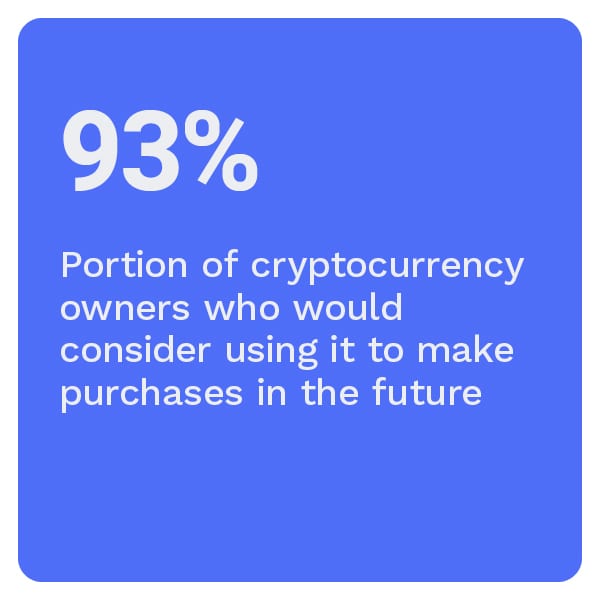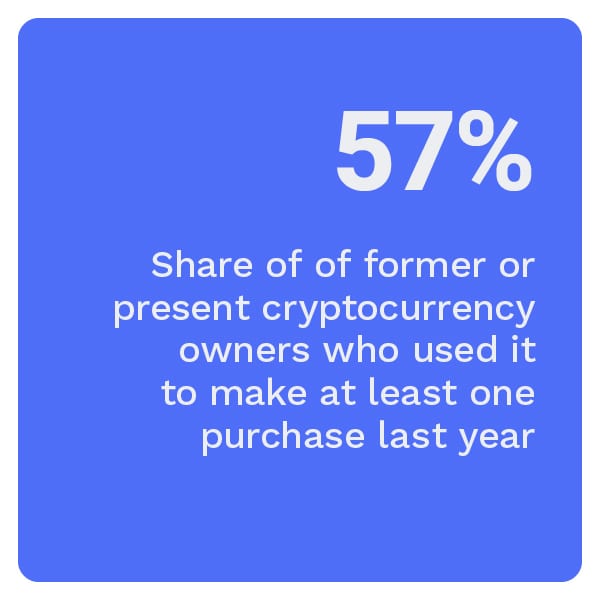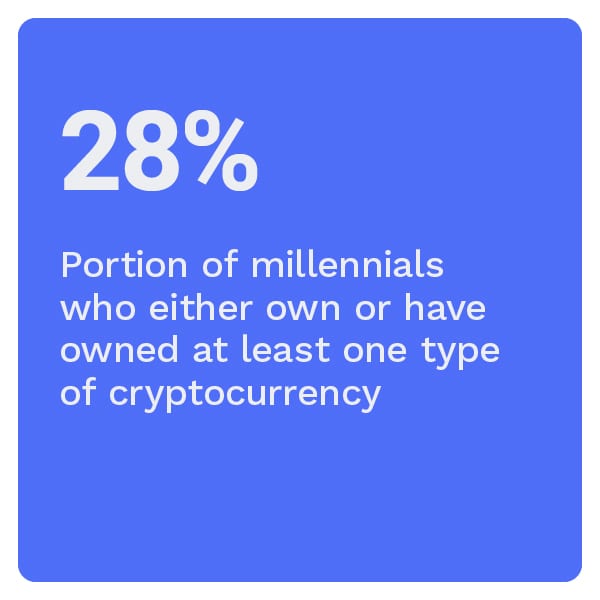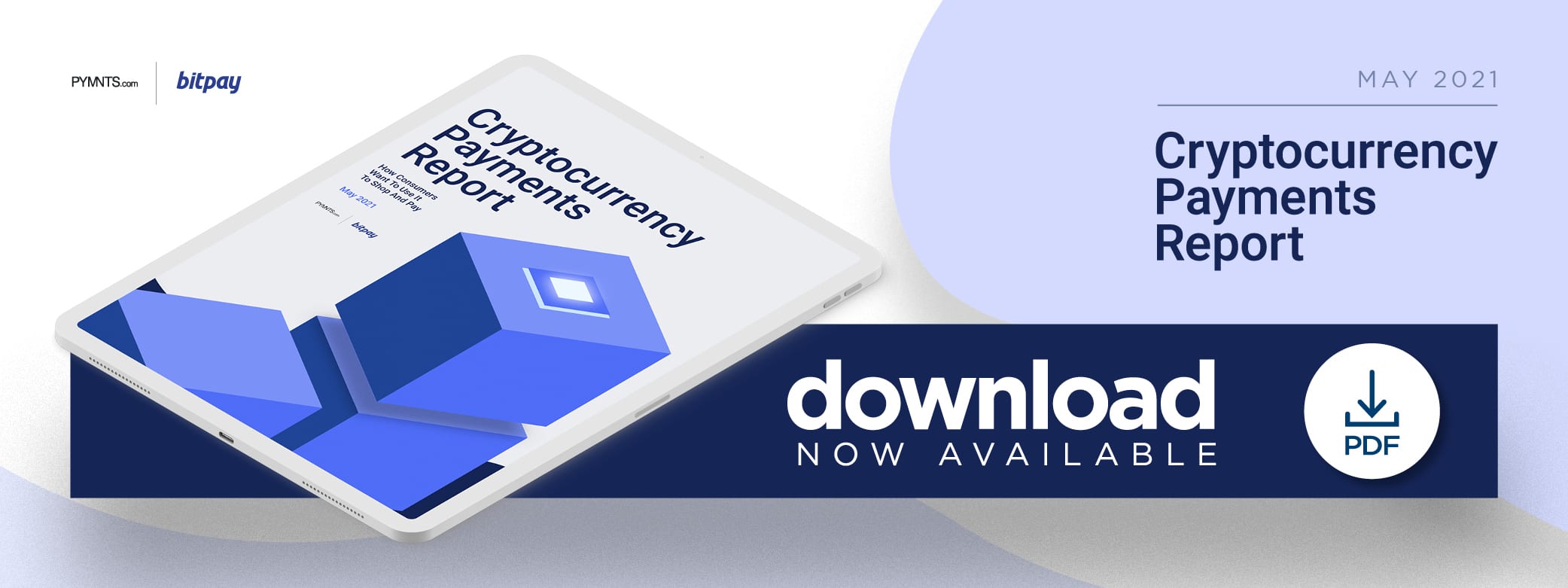NEW DATA: 46 Million Consumers Plan To Use Cryptocurrency To Pay Merchants

U.S. consumers see cryptocurrency as more than just a store of value: 46 million say they plan to use it to pay for everything from groceries to real estate. In the Cryptocurrency Payments Report, PYMNTS surveys 8,008 cryptocurrency users and nonusers in the U.S. to examine how they plan to use crypto to make purchases, what crypto they plan to use — and how merchant acceptance of crypto can influence merchant choice and consumer spend.
Cryptocurrencies have become increasing popular since bitcoin’s debut 12 years ago. Once considered obscure, cryptocurrencies are now one of the most talked-about payment topics and make headlines in the daily news. Mobile trading apps, meanwhile, make the buying and selling of cryptocurrency more accessible to the general public — and influencers such as Elon Musk either increase or decrease the interest of consumers.
With cryptocurrency  ownership increasing 63 percent in 2020 and the cryptocurrency market’s valuation exceeding $2 trillion for first time in April of this year, consumers’ interest in buying and spending cryptocurrency continues to rise, and consumers want to use these currencies to pay for retail purchases.
ownership increasing 63 percent in 2020 and the cryptocurrency market’s valuation exceeding $2 trillion for first time in April of this year, consumers’ interest in buying and spending cryptocurrency continues to rise, and consumers want to use these currencies to pay for retail purchases.
The Cryptocurrency Payments Report: How Consumers Want To Use It To Shop And Pay, a PYMNTS and BitPay collaboration, examines consumers’ current interest in and future plans for ownership and use of cryptocurrency. We conducted a census-balanced survey of 8,008 United States consumers who are current and former cryptocurrency users and cryptocurrency nonusers between Feb. 8 and Feb. 23, 2021.
Our analysis shows that not only do current cryptocurrency owners have a high level of comfort making purchases using cryptocurrencies, but so do those who have never owned them. Along those same lines, 57 percent of former or present cryptocurrency owners made at least one purchase using it last year, and 59 percent of consumers who never owned cryptocurrency are interested in using it to make purchases in the future. The fact that more than half of consumers who have never owned cryptocurrency are interested in using it in the future illustrates that consumers now perceive cryptocurrencies as a valid payment option.
It’s also important to note that as many as 46 million consumers (18 percent) would consider using cryptocurrency for retail purchases, regardless of whether they currently own cryptocurrencies or not. This means purchases using cryptocurrency could conservatively represent around 1 percent of retail sales in the next year.
Who are these cryptocurrency owners? PYMNTS research indicates that cryptocurrency owners are more commonly younger, middle-income and male. Nineteen percent of millennials currently own cryptocurrencies, as do 16 percent of middle-income consumers (those earning between $50,000 and $100,000 per year), 15 percent of men and
8.5 percent of women.
Crypto ownership is also more common among younger consumers, as millennials and bridge millennials are the most likely of all to already own cryptocurrency or to have owned it in the past. Our research shows that 27.6 percent of all millennials and 27.5 percent of bridge millennials either own or have owned at least one type of cryptocurrency. This is far more than the 16.7 percent of Generation X consumers and only 5.2 percent of baby boomers and seniors who own or have owned cryptocurrency, by contrast.
 PYMNTS research indicates that lack of knowledge, or not knowing enough about cryptocurrency, how to obtain it or its tax implications, is the most-often cited barrier for nonowners, as 75 percent do not purchase it for this reason. One-third of consumers who never purchased cryptocurrencies cite their not being mainstream or accepted enough as a reason why. This is most commonly cited among baby boomers and seniors (39 percent). A relatively smaller but significant share of respondents who have never purchased cryptocurrencies worry about their value being too volatile (25 percent).
PYMNTS research indicates that lack of knowledge, or not knowing enough about cryptocurrency, how to obtain it or its tax implications, is the most-often cited barrier for nonowners, as 75 percent do not purchase it for this reason. One-third of consumers who never purchased cryptocurrencies cite their not being mainstream or accepted enough as a reason why. This is most commonly cited among baby boomers and seniors (39 percent). A relatively smaller but significant share of respondents who have never purchased cryptocurrencies worry about their value being too volatile (25 percent).
These findings touch on just a few of the insights outlined in our research. To learn more about how consumers feel about using cryptocurrency and how merchants can ensure they are meeting customers’ needs, download the report.
